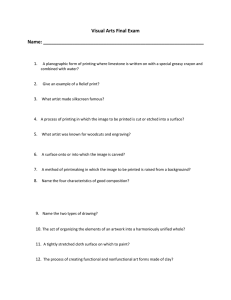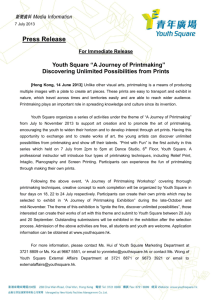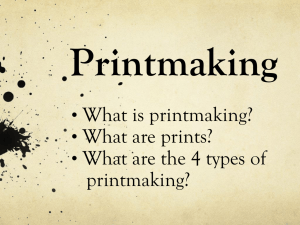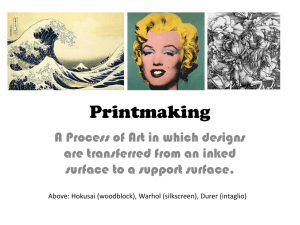The Instituons Training Printmaking Artist / Educator from 1923 To... and Their Conditions Saime Dönmezer
advertisement
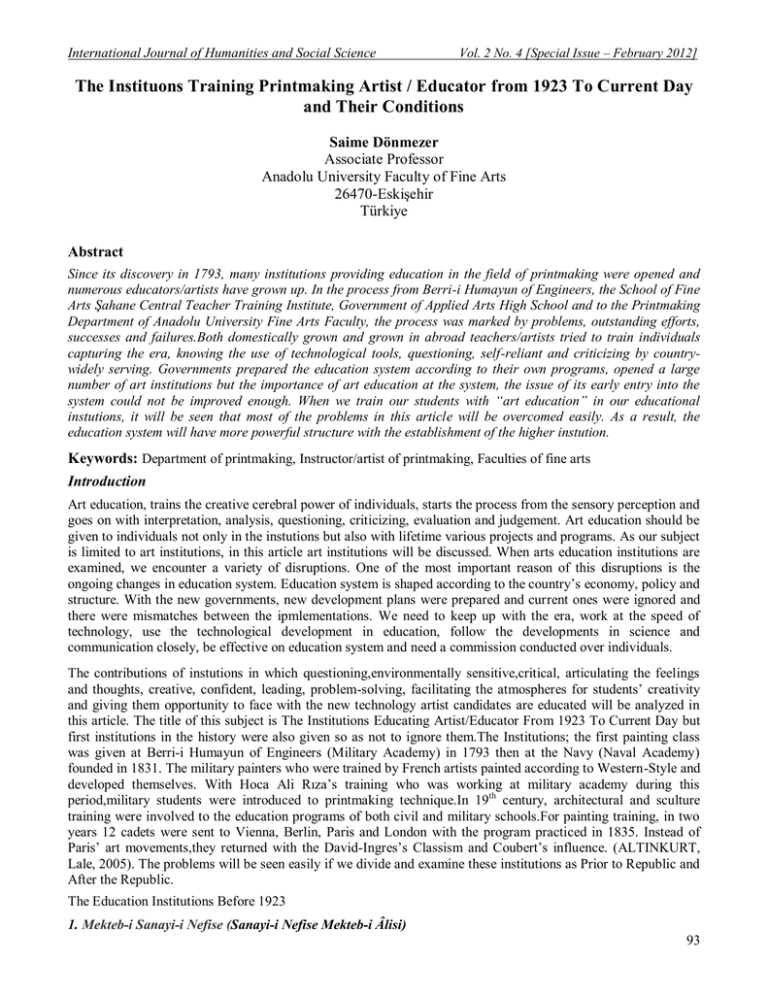
International Journal of Humanities and Social Science Vol. 2 No. 4 [Special Issue – February 2012] The Instituons Training Printmaking Artist / Educator from 1923 To Current Day and Their Conditions Saime Dönmezer Associate Professor Anadolu University Faculty of Fine Arts 26470-EskiĢehir Türkiye Abstract Since its discovery in 1793, many institutions providing education in the field of printmaking were opened and numerous educators/artists have grown up. In the process from Berri-i Humayun of Engineers, the School of Fine Arts Şahane Central Teacher Training Institute, Government of Applied Arts High School and to the Printmaking Department of Anadolu University Fine Arts Faculty, the process was marked by problems, outstanding efforts, successes and failures.Both domestically grown and grown in abroad teachers/artists tried to train individuals capturing the era, knowing the use of technological tools, questioning, self-reliant and criticizing by countrywidely serving. Governments prepared the education system according to their own programs, opened a large number of art institutions but the importance of art education at the system, the issue of its early entry into the system could not be improved enough. When we train our students with “art education” in our educational instutions, it will be seen that most of the problems in this article will be overcomed easily. As a result, the education system will have more powerful structure with the establishment of the higher instution. Keywords: Department of printmaking, Instructor/artist of printmaking, Faculties of fine arts Introduction Art education, trains the creative cerebral power of individuals, starts the process from the sensory perception and goes on with interpretation, analysis, questioning, criticizing, evaluation and judgement. Art education should be given to individuals not only in the instutions but also with lifetime various projects and programs. As our subject is limited to art institutions, in this article art institutions will be discussed. When arts education institutions are examined, we encounter a variety of disruptions. One of the most important reason of this disruptions is the ongoing changes in education system. Education system is shaped according to the country’s economy, policy and structure. With the new governments, new development plans were prepared and current ones were ignored and there were mismatches between the ipmlementations. We need to keep up with the era, work at the speed of technology, use the technological development in education, follow the developments in science and communication closely, be effective on education system and need a commission conducted over individuals. The contributions of instutions in which questioning,environmentally sensitive,critical, articulating the feelings and thoughts, creative, confident, leading, problem-solving, facilitating the atmospheres for students’ creativity and giving them opportunity to face with the new technology artist candidates are educated will be analyzed in this article. The title of this subject is The Institutions Educating Artist/Educator From 1923 To Current Day but first institutions in the history were also given so as not to ignore them.The Institutions; the first painting class was given at Berri-i Humayun of Engineers (Military Academy) in 1793 then at the Navy (Naval Academy) founded in 1831. The military painters who were trained by French artists painted according to Western-Style and developed themselves. With Hoca Ali Rıza’s training who was working at military academy during this period,military students were introduced to printmaking technique.In 19th century, architectural and sculture training were involved to the education programs of both civil and military schools.For painting training, in two years 12 cadets were sent to Vienna, Berlin, Paris and London with the program practiced in 1835. Instead of Paris’ art movements,they returned with the David-Ingres’s Classism and Coubert’s influence. (ALTINKURT, Lale, 2005). The problems will be seen easily if we divide and examine these institutions as Prior to Republic and After the Republic. The Education Institutions Before 1923 1. Mekteb-i Sanayi-i Nefise (Sanayi-i Nefise Mekteb-i Âlisi) 93 The Special Issue on Contemporary Issues in Social Science © Centre for Promoting Ideas, USA Resim1-2: Mekteb-i Sanayi-i Nefise, Osman Hamdi Bey II.Abdulhamit founded “Mekteb-i Sanayi-i Nefise-I ġahane’’ which was the first basis of fine arts in Turkey in 1882 and appointed Osman Hamdi Bey who is the first Turkish archaeologist and founder of the modern museology to it. (1842-1910). It was opened with the deparments of painting,sculpture and gravure in 3 rd March 1883. Gravure department stayed closed for 10 years because they were lack of educator for this department but it gained functionality with the arrival of Stanislas Arthur Napier from France in 1892. After Naiper, who worked there until 1897, Nesin Efendi was appointed and he worked there until the proclamation of republic. With the proclamation of republic,education programs were reformed in 1924 and a great number of young people were sent to Europe especially to France and Germany to get inspired from West and form our education program with the light of our culture. After their education,they returned to our country and contributed a lot to Anatolian People’s literacy. ġinasi Barutçu, Veysel Erüstün, Nurullah Berk, Zeki Faik Ġzer, Mustafa Aslıer, Bedri Rahmi Eyüpoğlu, Orhan Peker, NeĢet Günal, MürĢide Ġçmeli Alaattin Aksoy, Nevzat Akoral Muammer Bakır , Hüseyin Bilgin, Gören Bulut, Gündüz Gölönü, Güngör Ġblikçi, Mehmet Güler, Mustafa Pilevneli, Hayati Misman, Ali Teoman Germener, Adnan Turani, Atilla Atar ve Zahit BüyükiĢleyen are just some of these artists/educators. French academician Lepold Levy(1882-1966) came to Ġstanbul as the guest of government in 1936 and he became chief of ” Sanayi-i Nefise” whose name was changed as in 1928 and he founded the Gravure Studio,he produced there and he opened exhibitions. This studio provided new opportunities in Lithography with its power in gravure art and successful artists in abstract painting.With the studies of metal gravure, linoleum and litography the artistic authentic printmaking started and it was opened to other artists. (AKALAN 2000).First artists of this studio are Turgut Zaim and Levy’s assistant Sabri Berkel. Resim 3-4-5-6 : Leopold Levy, Sabri Berkel, Mustafa Aslıer, Turgut Zaim Apart from these two artists, Mustafa Aslıer, Aliye Berger, Muammer Bakır, Gündüz Gölönü, Mustafa Pilevneli, Bedri Rahmi Eyüboğlu, Eren Eyüboğlu, Nevzat Akoral and Cemal Tollu produced works in gravure technique. Printing studies in academy continued until 1984 and everything burnt with a fire in that year. As a result of this situation Levy returned to Paris.Works reflecting to that period existed with the studies of artists and students before the fire.In 1950s,the interest for printing raised and the production gained speed with the renewed printmaking studio in 1960. After Sabri Berkel, Fethi Kayaalp and Asım ĠĢler were appointed to the studio.There has not been serious attempts in this studio although it is the first academic foundation of printmaking. Despite numerous printmaking artists/educators,the issue of the place of printmaking which is still a part of the Graphic department should be considered seriously. Actually, when the foundation was founded, Engraving Department was opened but it could not survived. The individuals who are educated by an education foundation take place in the establishment and survival of another foundation. The second education foundation after Sanayi-I Nefise: 94 International Journal of Humanities and Social Science Vol. 2 No. 4 [Special Issue – February 2012] 2. Gazi Orta Muallim Mektebi ve Terbiye Enstitüsü Orta Muallim Mektebi ve Terbiye Enstitüsü, which was founded to educate modern teachers in 1926, was a foundation of educating of teachers and supervisors for primary and high schools. It was expanded in 1928-1929 and with the permission of Atatürk it was named as “ Gazi Orta Muallim Mektebi ve Terbiye Enstitüsü” in 1929. In 1932, painting department was opened and it became the second foundation by educating thousands of artists and art educators in Ankara. Ġsmail Hakkı Tonguç(1893-1960) who was head of department in 1932-1935 and he was the founder and first teacher of this foundation, he was also agent principal of it in 1935. Tonguç was assigned to establish “Sanayi -i Nefise Encümeni” (Güzel Sanatlar Kurulu) in the Mustafa Necati Uğural’s (18941929) period. Tonguç, also spent too much effort for the development of educational institutions after his post in here. Teachers are the key factor with their contributions to the development of Gazi Institute of Education. These teachers are Refik Epikman, Malik Aksel, ġinasi Barutçu, Mehmet Ali Atademir, Hakkı Uludağ, Hayrullah Örs, Mustafa Aslıer, Nevzat Akoal, Muammer Bakır, MürĢide Ġçmeli, Süleyman Saim Tekcan, Veysel Erüstün and with the support of scholarship, they were sent to abroad to be trained. Also, Atilla Atar, Mehmet Güler, Adem Genç, Hayati Misman and Hüseyin Bilgin were sent too, as secondary. Resim 7-8-9 :Muammer Bakır, Veysel Erüstün, MürĢide Ġçmeli When Muammer Bakır, Nevide Gökaydın, Nevzat Akoral, Hamza Ġnanç, Veysel Erüstün, MürĢide Ġçmeli, Hayatı Misman and Güler Akalan returned from abroad, they were appointed to the branch of Graphic Design which includes printing techniques in Gazi Institute of Education and these taachers/artists made some serious contributions to printmaking. The corporation took the name of Gazi Education Institute in 1976. Then, it was converted to Gazi University by the law No. 2809 in 1982. With the proclamation of Republic, Atatürk who gives importance to the problems of culture and art, added a new function like copping with them among the function of Government . In 1923: The nation does not paint, the nation does not sculpture and the nation does ignore the requirements of Science, it is obvious that this nation has no place on the road of developing. ( KAVCAR, 2003). To introduce the Turkish Culture and Arts to the world, Ataturk worked hardly. His encouragement was on doing research on this subject, opening some galleries, arranging congresses about culture. He said some encouraging words about art and artists. Some of these are: " A nation without art is fallen asunder without its life blood.." " You can all be congressman, delegate, even president of a republic but cannot be an artist." '" A Nation deprived of art and artist cannot live perfectly Atatürk founded many institutions on a task of training artists. He sent some paintings and sculptures to Europe in the aim of developing the Modern Turkish Arts and also many students to be trained in music. These are all showing us his featuring about arts.z..(www.ataturkinkilaplari.com) The Great leader, who oftenly emphasized that art is the one of culture's problems, defended that issues in art's education cannot be dealt and examined without the troubles in Natinoal Education and he got many serious researches done. As an example of them: John Dewey analyzed schools in Turkey with the advice of Mustafa Necati, who was Atatürk's close-friend, took part in Kuvay-i Milliye movement, was deputy in TBMM for its first three period. John Dewey stated that on his report: 'Turkish youth has bright potential and artistic talent, so they can make huge contributions to the culture of arts if they are trained well.. Dewey visited the academy of Fine Arts in Ġstanbul and stated that it really needs a new place for reaching it's targets. German instructor Stiehler, who was invited to Turkey in 1926 also made some suggestions about schedule and structuring in educating. Stiehler said that : 'Learner's talents will be improved with the help of painting and handicraft. Then,they can recognize the value of arts.This is not art directly, but it is a way of directing persons to art. 95 The Special Issue on Contemporary Issues in Social Science © Centre for Promoting Ideas, USA Art can only be performed with these talented-persons. Stiehler expressed that civics, enviroment and folk arts must be examined. Ġsmail Hakkı Baltacıoğlu who sent to abroad for firstly as first Turkish Art Teacher made some important studies in these years. One of them is the 'Teaching Course of Painting' opened in 1927 in Academy of Fine Arts. These steps supported the next demonstrations. Educational Institutions After 1923 1. Fine Arts High School It was opened in Istanbul in 1955. Bauhaus was a school in Germany that combined crafts and the fine arts, and was famous for the approach to design that it publicized and taught in 20. Century. It was founded with the idea of creating a 'total' work of art in which all arts, including architecture would eventually be brought togetherand it became a production-center. According to Gropius, a new architecture style which has more functional, inexpensive and durable products must have started after the war. With that, Gropius wanted to design functional and artistic products with the combination of art and craft. Assigned to Graphic department in 1958, Mustafa Aslıer made the engraving shop worked . The interest increased with this shop and many artist from other areas printed in there. Aliye Berger, Bedri Rahmi Eyupoğlu, Cihat Burak Erol Denenç, Uğur Üstünkaya, Mustafa Pilevneli, Ergin Ġnan ilk kuĢak sanatçılarıdır. Sabiha Erengül, Ali Ġsmail Türemen, Fevzi Karakoç, Ergin Ġnan, Hanefi Yeter, Mahmut Celayir, Demet Hamzaoğlu, Berna Türemen, Yalçın Özel, Hüsamettin Koçan, Muammer DurmuĢ, Emre Becer, Sema Ilgaz Temel ve Tayfun ErdoğmuĢ, Yalçın Özel ve Kadri Özayten are some of these artists. The institution made some innovations and passed new 4-year bachelor's program in 1962. Prof. Dr. Adolf Schneck was assigned to there to make the programs and select lecturers in 1956. There were 5 deparments Decorative Painting, Graphic Arts, Ceramics, Textile Arts, Furniture and Interior Design at the beginning.. The institution applied experimenting, practing and researching methods, it's education schedule was oftenly discussed, many innovations were made by the improvements brought with the centuries.In 20 th of July in 1982, Devlet Tatbiki Güzel Sanatlar Yüksekokulu was included in Marmara University with the law of higher education.( M.Ü. G.S.F. History) Graduates of Printmaking have found a lot of job opportunities as free artists,graphic artists,educators and academicians since its establishment.Being a printmaking artist or giving/taking education in this field necessitate a great technical support and equiptment.Some establishments can not afford them.Some foundations support these establishments. Rectors and Deans of Anadolu University supported theier development and they will continue,too.The education of academical personnel of the department is provided by the university both domestic and foreign sources.Within this support,printmaking departments and printmaking education are examined by the national agreements .Department demonstrations are done with joint workshops,seminars and conferences.The educators and students of the department organize a lot of activities such as Fairs-Biennilas to introduce the department to the large masses. It is emphasized from the beginning to the end of the article that there are a lot of printmaking establishments but they are not developed enough.Examples of printmaking in establisments as a department is finite to 1 or 2.The education foundations in Turkey rised,there is a Fine Arts Department in almost every city but printmaking has not taken attention that much.The number of the personnel in printmaking is numerous but it is not parallel with the enterprise of establising the department.Unless the quality and number of this department are developed,educating qualified artist/educator in this field is very hard. Every change in governments effects education foundations both positively and negatively.Governments’ plans for education are very wide but they do not stick to the programs in implementation.Unless the problems are solved in basic education and art education is included to the basic education,future generations will have huge cultural and artistic gaps.These gaps show us the cause of minority of art foundations.I will repeat my sentence which I always say:In our education system,foundations should be taken over by a supreme foundation,it should not be effected from any change and it should include every kind of view equally.Implementations of this foundation will solve a lot of problem.The creativity of the individuals who will be given art education will be so much wider in the establishments in which more hopeful individuals are educated. Another important establishment is Fine Arts Faculty of Dokuz Eylül University: It was founded in 1975 within Ege University and it carries on education by gathering branches of arts and training methods together. 96 International Journal of Humanities and Social Science Vol. 2 No. 4 [Special Issue – February 2012] The most important problem which Faculty faced in establishing period;there were not enough educators in Ġzmir which was developing in culture and arts so accumulation of experiences could not be transferred enough.Generally,these kind of artists/educators prefer Ġstanbul or Ankara.Faculty developed with the efforts of devoted artists/educators.The other problem which faculty faced was the faculty could not be run completely due to the insufficient funds.All of the problems were overcomed.In this faculty,printmaking is lectured in Graphics and Painting Departments.Faculty’s contributer in establishment and lecturer in it,educator/artist Gören Bulut,who returned country after getting master’s degree,continued contributing from 1986 to 2005.Other faculties were opened in several cities but they could not developed enough. Unlike their number in establishment period,we now have 67 Fine Arts Faculties and 29 Fine Arts Departments within education faculties.Unfortunately,only Anadolu University and Balıkesir University have Printmaking Deparment. 2. Fine Arts Faculty Printmaking Department of Anadolu University Printmaking Department of Anadolu University within the Fine Arts Faculty started education in 2000-2001 academic year although its application was made long before. Prof. Dr Engin Ataç and Prof. Atilla Atar have great contributions in foundation of this department.This foundation which was opened to meet the need of artists/educators of our country,” Department of Printing Arts,focused on the individual's creative potential to uncover their differences with a perception to contemporary art in a parallel manner,gives required education to understand the nature of arts,artistic culture,visual thinking and free interpreting in this direction.In Department of Printmaking; infrastructure equipment required by the process of 4-year training program,approaching differences without prejudice according to the identity of the contemporary artist,freely thinking,exploring and development of problem-solving methods are based.It provides intellectual and proffesional training to students by offering modern and efficient program in its field. (A.Ü.G.S.F. Printing Arts Department History) REFERENCES Akalan, G. (2000). Gravür. Kaleseramek sanat yayınları Altınkurt. L. (2005). Türkiye’de Sanat Eğitiminin Gelişimi. Dumlupınar Üniversitesi Sosyal Bilimler Dergisi, Sayı:12, Afyon Aslıer, M. (1985). Son Yüzyılda Türkiye’de Özgün Baskıresim Sanatı. Türkiye’de Sanatın Bugünü ve yarını, 1. Ulusal sanat Sempozyumu, Hacettepe Üniversitesi, Güzel Sanatlar Fakültesi Yayınları No:1, Beytepe, Ankara, 31-38. Aslıer, M. (1978). Türk Özgünbaskı Resim Sanatında Tahta Oyma-Basma’nın yeri. Türkiye’de ve Almanya’da Ağaçbaskı Sanatı, Hacettepe Üniversitesi, Güzel Sanatlar Fakültesi Yayınları No:6, Ankara, 1-4. Atar, A. (1995). Başlangıcından Günümüze Taşbaskı. Anadolu Üniversitesi Yayınları; No: 846, Güzel Sanatlar Fakültesi Yayınları; No: 9, EskiĢehir Aydın, A. (2003). Cumhuriyet Sonrası Türkiye’de Eğitim, Osmangazi Üniversitesi, Eğitim Fakültesi, EskiĢehir Boyancı, S. (1994). Türk Gravür Sanatının Tarihsel Gelişimi, Gazi Üniversitesi, Sosyal Bilimler Enstitüsü, Uygulamalı Resim Egitimi Ana Bilim Dalı, Yüksek Lisans Tezi, Ankara 139. Bulut, G. (1978). Tahtabaskı ve Tahtagravür’e Teknik YaklaĢımlar Türkiye’de ve Almanya’da Ağaçbaskı Sanatı, Hacettepe Üniversitesi, Güzel Sanatlar Fakültesi Yayınları No:6, Ankara 5-9. Derman, G. (1989). Resimli Taş Baskısı Halk Hikayeleri, Atatürk Kültür Dil ve Tarih Yüksek Kurumu, Atatürk Kültür Merkezi-Sayı: 24, Türk Halk Hikayeleri Dizisi Sayı: 1, Ankara Emrali, R. (2007). Çağdaş Sanat Eğitimi Yapılandırma Önerileri. Atatürk Üniversitesi. Sanat Güzel Sanatlar Fakültesi Dergisi, Sayı:13, Erzurum Erinç, S. M.(1988). Sanat ve Eğitimi. Uludağ Üniversitesi, Eğitim Fakültesi Dergisi, Cilt:3, Sayı:1, Bursa Genç, A. (1985) Grafik Sanatlar Lisans Eğitiminde, Yatay(Lateral) Düşünme ve Tasarlama Süreçleri. Türkiye’de sanatın Bugünü ve yarını, 1. Ulusal sanat Sempozyumu, Hacettepe Üniversitesi, Güzel Sanatlar Fakültesi Yayınları No:117-19 Nisan, Beytepe, Ankara, 55-60. Gökaydın, N. (1978) Tahtabaskı tekniği, Dünü Bugünü, Eğitimdeki Yeri Türkiye’de ve Almanya’da Ağaçbaskı Sanatı, Hacettepe Üniversitesi, Güzel Sanatlar Fakültesi Yayınları No:6, Ankara, 45-53 97 The Special Issue on Contemporary Issues in Social Science © Centre for Promoting Ideas, USA Ġçmeli, M. (1985) Çağdaş Açıdan Türk Grafik Sanatları. Türkiye’de sanatın Bugünü ve yarını, 1. Ulusal sanat Sempozyumu, Hacettepe Üniversitesi, Güzel Sanatlar Fakültesi Yayınları No:1 17-19 Nisan, Beytepe, Ankara, 61-67. Ġçmeli, M. (1978) Ağaç Baskıresmin Özgün Baskıresimdeki Yeri, Türkiye’de ve Almanya’da Ağaçbaskı Sanatı, Hacettepe Üniversitesi, Güzel Sanatlar Fakültesi Yayınları No:6, Ankara, 55-62. Ġz Bölükoğlu, H. (2002) Bilgi Çağında Eğitim Fakültelerinde Resim-İş Eğitiminin Genel Bir Değerlendirmesi. Gazi Üniversitesi Gazi EĞitim Fakültesi Dergisi, Cilt 22, Salı 3, 247-259. Kalafat, A., Tutku. D. (2007) Türk Gravür Baskı Sanatının Doğuşu ve Öncü Bir Sanatçı: Mürşide İçmeli, Karadeniz AraĢtırmaları, Sayı 1, 142. Kıran, H. (2010) Ağaç Baskı Sanatı, Bellek Yayınları, Ankara Özsezgin, K. (1978) Ağaçbaskı ve Türk Ressamları Türkiye’de ve Almanya’da Ağaçbaskı Sanatı, Hacettepe Üniversitesi, Güzel Sanatlar Fakültesi Yayınları No:6, Ankara. 77-82. Pekmezci, H. (1992). Tümyönleriyle Serigrafi İpekbaskı. Ġlke Yayıncılık, Ankara San, Ġ. (1983) Sanat Eğitimi Kuramları. Tan Kitap Yayın ve Ticaret Ltd. ġti. AnkaraSönmez, M. (2004) Öğretmen Yetiştirme. Ankara Üniversitesi Eğitim Bilimleri Enstitüsü Eğitim Yönetimi TeftiĢi Planlaması ve Ekonomisi Anabilim Dalı (Tez)Ankara ġener, D. (2007) Kentin Boşluğunda İnsan, Milliyet Sanat, ss.21 Tekcan, S. S. (1978) Ağaçbaskı Teknolojisi ve Sanatsal Baskılar. Türkiye’de ve Almanya’da Ağaçbaskı Sanatı, Hacettepe Üniversitesi, Güzel Sanatlar Fakültesi Yayınları No:6, Ankara. 83-85. Tekin, KiriĢoğlu.O. (1991) Sanatta Eğitim, görmek .anlama. yaratmak. Eğitim Kitapevi, Ankara Türkdoğan, G. (1984) Sanat Eğitimi Yöntemleri. Kadıoğlu matbaası, AnkaraUysal, S. (1996) Sanat Eğitimi Üzerine. Milli Eğitim Dergisi, Türkiye’de Resim ve Resim Eğitimi Özel Sayısı, Ankara www.forumgercek.com/archive/index.php/t-44512.html www.newkon.net/baski-sanati.html www.turkresmi.com/klasorler/ozgunbaski/index.htm www.gorselsanatlar.org/arsiv/turkiye'de-ozgun-baski-resim- sanati-ve-bazi-sanatcilar www.frmtr.com/kultur/2711803-turk-grafik-sanatinin-tarihi.html http//gsf.marmara.edu.tr/index.php?sayfa=4 http//www.bibilgi.com/ansiklopedi/Gazi-Eğitim-Enstitüsü 98
